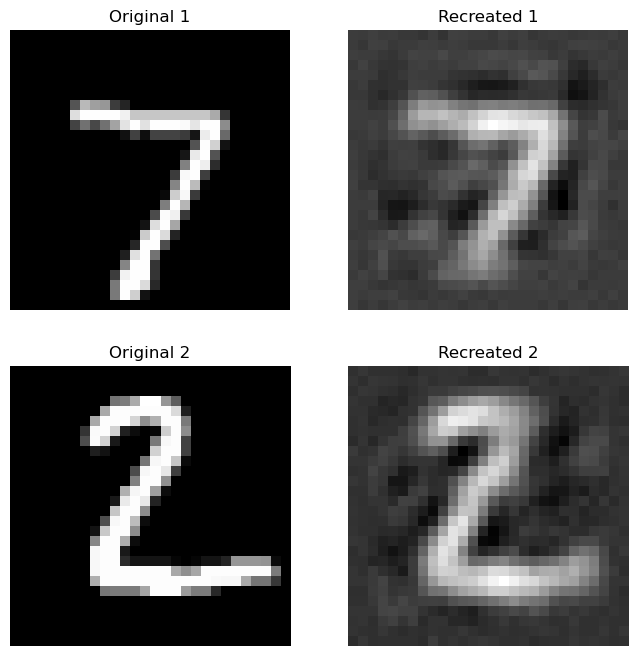Lecture 18: Failures in data privacy#
Learning objectives#
By the end of this lecture, students should be able to:
Understand why encrypted data might not be as private as we thought
Understand how anonymized data can be reverse-engineered
Understand how models can be inverted to extract input data
Slides#
Note
Download a PDF version here
Example of model inversion in neural network using MNIST data#
# !pip install torch torchvision torchaudio
First, we train a NN with two parts to simulate the Split Neural Networks (SplitNN), which is a training paradigm in which part of a network is hosted on a data holder’s device and the second part of the network is hosted on another device.
from torch import nn, optim
class SplitNN(nn.Module):
def __init__(self):
super(SplitNN, self).__init__()
self.first_part = nn.Sequential(
nn.Linear(784, 500),
nn.ReLU(),
)
self.second_part = nn.Sequential(
nn.Linear(500, 500),
nn.ReLU(),
nn.Linear(500, 10),
nn.Softmax(dim=-1),
)
def forward(self, x):
return self.second_part(self.first_part(x))
target_model = SplitNN()
Let’s assume the target model has been trained on the MNIST dataset and that we can access the size 500 vector output from the model’s first_part
class Attacker(nn.Module):
def __init__(self):
super(Attacker, self).__init__()
self.layers = nn.Sequential(
nn.Linear(500, 1000),
nn.ReLU(),
nn.Linear(1000, 784),
)
def forward(self, x):
return self.layers(x)
Create data loader
from torchvision import datasets, transforms
from torch.utils.data import DataLoader
# Define transformations for the EMNIST dataset
transform = transforms.Compose([
transforms.ToTensor(),
transforms.Normalize((0.5,), (0.5,))
])
# Load the EMNIST dataset
emnist_train = datasets.EMNIST(root='data', split='balanced', train=True, download=True, transform=transform)
emnist_train_loader = DataLoader(emnist_train, batch_size=64, shuffle=True)
Downloading https://biometrics.nist.gov/cs_links/EMNIST/gzip.zip to data/EMNIST/raw/gzip.zip
100%|██████████| 562M/562M [00:20<00:00, 27.6MB/s]
Extracting data/EMNIST/raw/gzip.zip to data/EMNIST/raw
# Load the MNIST dataset
mnist_train = datasets.MNIST(root='data', train=True, download=True, transform=transform)
mnist_train_loader = DataLoader(mnist_train, batch_size=64, shuffle=True)
mnist_test = datasets.MNIST(root='data', train=False, download=True, transform=transform)
mnist_test_loader = DataLoader(mnist_test, batch_size=64, shuffle=False)
Perhaps we don’t know exactly what data the target model has been trained on, but we do know that it’s some sort of handwritten images.
Therefore we can use part of the EMNIST dataset of handwritten letters to train our attacker.
# Initialize the attacker model and optimizer
attacker = Attacker()
optimiser = optim.Adam(attacker.parameters(), lr=1e-4)
# Training loop
for data, targets in emnist_train_loader:
# Flatten the input data
data = data.view(data.size(0), -1)
# Reset gradients
optimiser.zero_grad()
# First, get outputs from the target model
target_outputs = target_model.first_part(data)
# Next, recreate the data with the attacker
attack_outputs = attacker(target_outputs)
# We want attack outputs to resemble the original data
loss = ((data - attack_outputs) ** 2).mean()
# Update the attack model
loss.backward()
optimiser.step()
Let’s plot our original data against the recreated data
import matplotlib.pyplot as plt
# Testing loop
for data, targets in mnist_test_loader:
# Flatten the input data
data = data.view(data.size(0), -1)
# Get outputs from the target model
target_outputs = target_model.first_part(data)
# Recreate the data with the attacker
recreated_data = attacker(target_outputs)
# Plot the first 2 original and recreated images for comparison
fig, axes = plt.subplots(2, 2, figsize=(8, 8))
for i in range(2):
# Original image
axes[i, 0].imshow(data[i].view(28, 28).cpu().detach().numpy(), cmap='gray')
axes[i, 0].set_title(f"Original {i+1}")
axes[i, 0].axis('off')
# Recreated image
axes[i, 1].imshow(recreated_data[i].view(28, 28).cpu().detach().numpy(), cmap='gray')
axes[i, 1].set_title(f"Recreated {i+1}")
axes[i, 1].axis('off')
plt.show()
break # Only plot for the first batch

